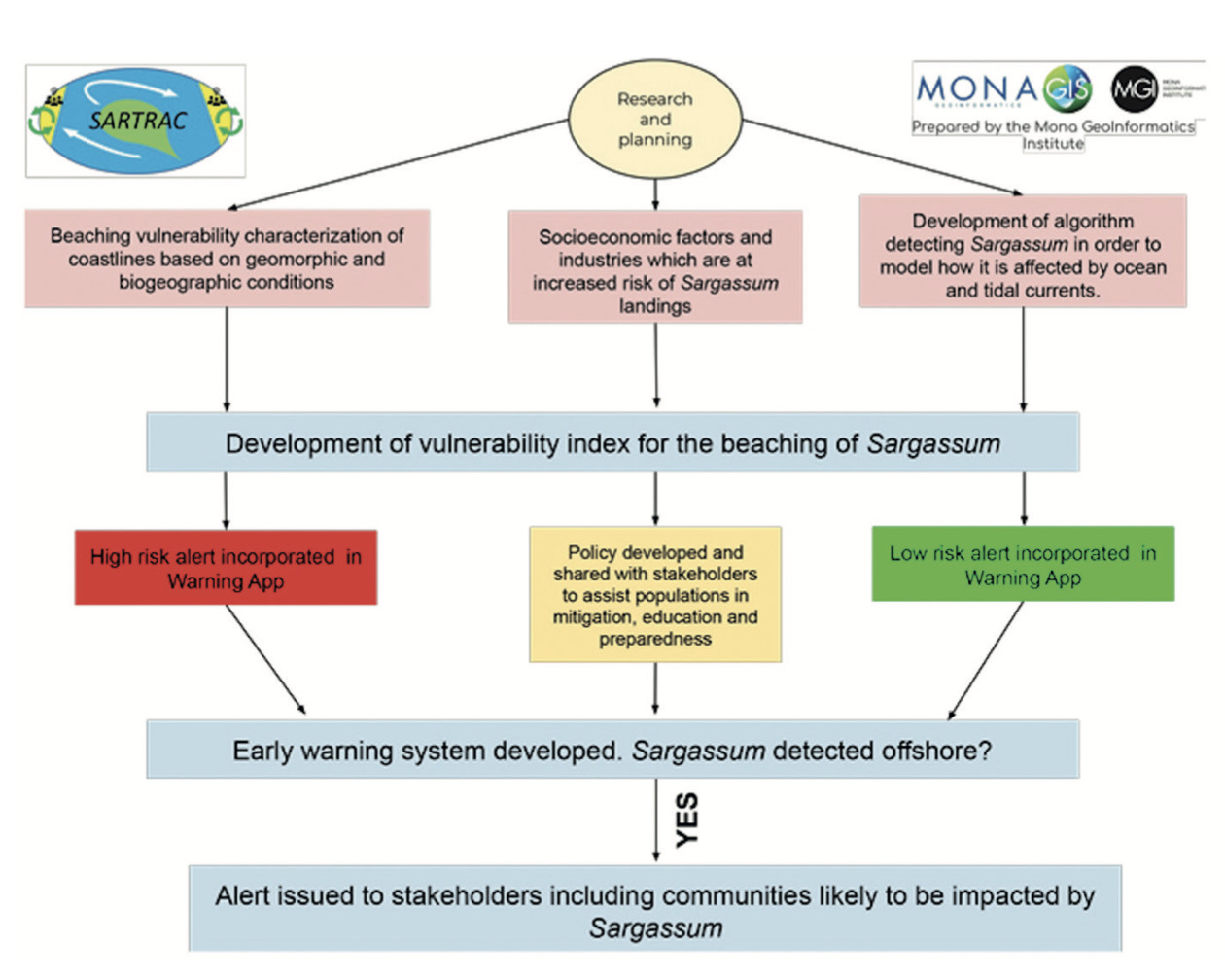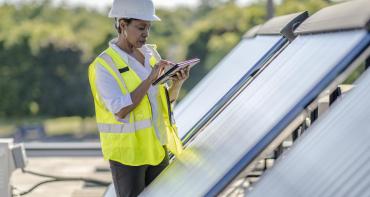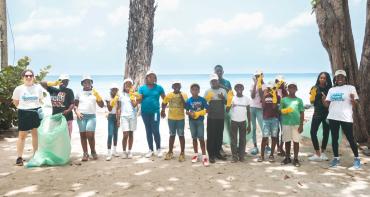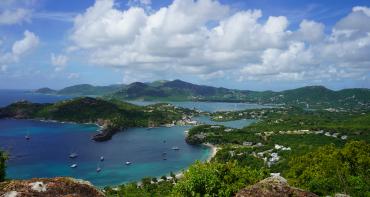The stranding of floating seaweed (Sargassum) rafts is a recent regular phenomenon affecting Atlantic coastal nations of the Caribbean, Central America and tropical West Africa. While the reasons for this unusual landfall are not yet fully understood, affected communities must find ways to deal with the seaweed, which can smother beaches, block harbours and become toxic to humans and wildlife as it decomposes, with adverse effects on vital fishing and tourism activities. Its effects are felt most strongly by vulnerable small island developing states.

Share your own case study with us
“Sargassum represents both a threat and an opportunity for Caribbean states. Entrepreneurs are developing innovative products from Sargassum, such as fertilisers, cosmetics and pharmaceuticals. The scientists on the SARTRAC teams are assisting this process by investigating and advancing processes for monitoring and forecasting, and by exploring novel ways for transformative adaptation of Sargassum to empower communities whose livelihoods have been affected by this ecological risk, to turn it into an opportunity.”
Dr Janice Cumberbatch, country and project lead for University of West Indies, Cave Hill campus (Barbados).
“Sargassum is a major threat to vulnerable coastal communities in Ghana. It is impacting negatively on the small-scale fishing industry, which is a major source of livelihood in poor communities. SARTRAC will enable the poorest of the poor in vulnerable communities to discover the economic potentials of Sargassum to enhance their adaptive capacity.”
Prof. Kwasi Appeaning Addo, Director for the Institute for Environment and Sanitation Studies, University of Ghana.
The SARTRAC project is an initiative to confront this problem on many levels: by improving the observation of oceanographic conditions to better forecast stranding events; by developing options to utilise or benefit from the stranded seaweed; and by enabling the sharing of information among affected communities to better manage a coordinated response.
The project was launched shortly before the outbreak of the COVID-19 pandemic; however, a determined and resourceful management team has maximised the potential of alternative working practices to deliver significant early progress that will bear fruit on the ground in affected nations as soon as pandemic restrictions allow. Such progress includes the creation of an online presence, building the skillset of its team to accommodate remote working, convening virtual capacity-building workshops on both sides of the Atlantic and publishing early findings from scientific efforts to better detect floating Sargassum rafts and their movement using remotely observed data.
Challenges other than pandemic restrictions have included overcoming delays associated with changes in political leadership in some partner countries, as well as ensuring an adequate provision of technical capacity for coordinated remote working across the partnership.
The issue
Since 2011, Sargassum, a type of seaweed, has been forming extensive floating mats that drift with the wind and currents across the 5,500 longitudinal miles of the tropical Atlantic Ocean. Prior to 2011, large accumulations of the seaweed were commonly only found in the sub-tropical northern Atlantic Ocean (The Sargasso Sea), where it is considered a floating forest, providing food, home and temporary shelter to numerous marine species.
Anomalous weather events, strong winds and currents, together with increased nutrient availability and a warmer ocean, have led to the proliferation of large rafts of Sargassum, including a previously rare species variant, washing up on coastlines across the Atlantic tropics in staggering quantities and being blown ashore. In 2018, some rafts grew in size to more than 1.3 million square meters (approximately the size of 250 football pitches). The Sargassum mass stranding phenomenon affects North, South and Central America’s eastern shores, the Caribbean islands and the coast of West Africa, impacting coastal communities in over 30 countries. Decomposing stranded Sargassum can have damaging effects on human health, beach access, fishing, tourism and nearshore marine communities. The sudden influx of Sargassum on vulnerable coastlines has been difficult to predict, as such extraordinary strandings can vary seasonally, annually and spatially across its range. Improving the predictability of Sargassum strandings, and developing ways to create benefits from the seaweed when it does strand, is the impetus for the SARTRAC project.
The response
The Sargassum seaweed influxes mainly affect developing countries, with the exception of the United States and
a few Caribbean islands. In most cases, the lives and livelihoods of coastal communities are directly affected, as are the key sectors that rely on coastal access and healthy seas, notably fisheries and tourism. The SARTRAC project explores how Sargassum seaweed can be used to reduce poverty. Specifically, the project has three goals:
- to identify how to minimise the negative impacts of Sargassum on the poorest;
- to identify whether Sargassum can be used to build adaptive capacity to natural hazards;
- to assess whether Sargassum can improve the economic opportunities of the poorest affected groups.
Four main areas of research are being pursued to deliver these goals. The first is an assessment of the atmospheric and oceanographic drivers of Sargassum across the tropical Atlantic Ocean. This information is used to develop long-term (6-9 month) forecasts of Sargassum movement across the Atlantic and will be available for country governments to download and access for use in their Sargassum seasonal planning. The second area is to develop a near real-time early warning system for vulnerable coastal communities to predict where, when and how Sargassum will reach land. Satellite imagery, combined with drone monitoring, enables locally sensitive prediction of events in the days prior to landing. The third area involves identifying the most vulnerable communities as well as their potential adaptation strategies to deal with stranded Sargassum, both of which are key elements of the project. Biochemical analysis of the seaweed, together with local experimentation, is essential to ascertain its utility. Three options being explored are:
- the role of Sargassum as compost for mangrove seedlings, to support mangrove regrowth to protect against storm surges;
- small scale biogas production from the controlled decomposition of Sargassum;
- opportunities for using Sargassum as a fertiliser for growing tomatoes and corn.
The capacity and adaptability of affected communities to analyse and make best use of the stranded Sargassum is assisted by a centralised knowledge hub, through which they submit findings and can share experiences of success or failure as well as forge collaborative partnerships.

Sargassum detection algorithm using remote and direct observation data.
The fourth area of research is to explore how improved management of Sargassum can increase the opportunities that are available to the poorest communities. Together, these four areas are generating tools (e.g., a long-range forecast system is in development), resources (e.g., a severity index has been developed that can be applied in other areas) and knowledge to support pathways out of poverty for those affected.
Partnerships and support
The SARTRAC partnership comprises an interdisciplinary team of six research collaborators from four countries, led by the University of Southampton (United
Kingdom), and includes the University of Ghana, the Mona Geoinformatics Institute at the University of the West Indies (Jamaica campus), the Centre for Marine Studies at the University of the West Indies (Jamaica campus), the Centre for Resource Management and Environmental Studies at the University of the West Indies (Barbados campus), and the Centre for Novel Agricultural Products at the University of York (United Kingdom).
All the partners are involved in the design, implementation and budgeting of the project. Specific project goals are delivered by subgroups of the consortium, with the Centre for Marine Studies, in collaboration with the Centre for Novel Agricultural Products, leading the collation and analysis of potential uses for Sargassum; the Mona Geoinformatics Institute leading the mapping of the impacts of Sargassum on the Jamaican coast; and the Centre for Resource Management & Environmental Studies leading the stakeholder engagement programme and exploration of governance models, whilst collaborating with the University of Ghana and the University of Southampton on developing Sargassum tracking models. Overall, SARTRAC is a truly collaborative programme, with all partners contributing, generating and gaining knowledge in equal measure.
The project is funded by the UK Research and Innovation Fund and the UK’s Global Challenges Research Fund under an Economic and Social Research Council grant. As of March 2021, a further two externally funded grant applications to develop capacity-building resources have been won by the consortium. The project is scheduled to run from November 2019 to October 2022.

Framework for the development of an early warning system for Sargassum strandings in the Caribbean and Ghana.
Results, accomplishments and outcomes
Despite restrictions imposed during the COVID-19 pandemic, progress has been made and remote meetings via virtual platforms have been possible.
The project has forged ahead with building its online profile, developing a dedicated website and social media presence and furnishing both with recorded interviews of key partners detailing their main findings to date and their plans. The programme of capacity-building has been delayed due to travel restrictions; however, online work has started to bring all partners’ skillsets and technical capacity to the same level.
Three capacity-building workshops have been held virtually with stakeholders to develop the mapping and social science skills necessary to deliver progress on all the project’s work elements. Field work, further in-person stakeholder engagement and training events as well as data analysis and dissemination events remain to be carried out once global travel restrictions are lifted.
Progress on the scientific front so far includes:
- Development of a prototype long-term (up to 180 days hence) seaweed forecast system SARTRAC- EFS (EFS = Ensemble Forecast System). The EFS predicts a high level of Sargassum will affect Jamaica in the summer of 2021. This prediction is currently being analysed and validated with ground-truth data from Jamaica and satellite observations. The consortium is planning to work with stakeholders to better understand how this information can be shared with them.
- Three geomorphological characteristics appear important in determining where Sargassum will beach with the greatest severity. In Jamaica, these places are: coves, open coast and narrow shelf areas with steep bathymetry near shore, with coastal areas with mangroves appearing the least severely affected. A severity index is being created that is transferable to other locations.
- To support the growth of red mangrove seedlings, composts containing different proportions of Sargassum have been investigated. After 31 weeks, the compost with 75 per cent Sargassum was the best, whereas 100 per cent Sargassum showed the poorest health and loss of succulence. Research is ongoing to assess the best ways to use Sargassum for agricultural purposes.
- National level strategies to manage an increased frequency of Sargassum strandings are well developed. However, regional and international coordination is hampered by size-related capacity constraints in small island developing states that also suffer disproportionately from major stranding events. Alternative governance frameworks and strategies are being explored.
Results from remote sensing, tracking and forecasting of Sargassum movements have been published in the scientific literature, while an evaluation of several satellite-based Sargassum detection algorithms to select the most suitable has been performed. Experiments on the chemical stability of stranded Sargassum and its utility for various applications has started, with useful preliminary results. Maps of past stranding events have been created for Jamaica to show where the worse impacted areas are located. Theoretical frameworks to assess adaptation potential and future cooperative governance scenarios for Sargassum have been developed.
Challenges
As well as challenges presented by the COVID-19 pandemic, others have emerged during the course of the project thus far that have had to be overcome.
Between the project’s inception and the granting of its funding, significant progress was made on the topic of Sargassum and its coordinated management – e.g., the establishment of the United Nations Environment Programme (UNEP) Sargassum Working Group – that overlapped with some intended project deliverables and had to be accommodated retrospectively into the project’s plans. Challenges were also encountered during the lead-up to the launch of the project by the holding of national elections in Ghana and the United Kingdom; these events reduced momentum, attention, visibility by potential stakeholders and the certainty of political backing over the intended lifetime of the project. Recruitment of staff for key posts in partner institutions could not proceed until the project contract was signed, resulting in a delay between the project launch and the commencement of new staff. Concurrent financial and corporate restructuring in UK partner institutions also had knock-on effects on the stability of key roles.
Stakeholder engagement has been difficult under pandemic restrictions and only successful with those having stable internet connectivity; as a result, those most able to engage have been national government departments, large multi-national organisations (UNEP) and international Sargassum researchers. Engagement with target communities has not yet been possible. Alternative plans are in development to enable the use of app-based data-recording instruments that can be accessed via mobile/cell phones.
Key lessons learnt
Initial assessment has revealed that regional environmental governance structures in the Caribbean are well placed to support adaptation strategies for an increased frequency of Sargassum strandings. However, the cost of coordination of such cooperative and polycentric environmental governance frameworks is relatively high for many small island developing states in the region, which can suffer disproportionately from major stranding events. Alternative governance frameworks and strategies are being explored. To advance project findings, more localised monitoring data are needed to allow countries to more accurately assess the severity of Sargassum landing events. These should be collected over the coming year.
Given the need for most staff to work from home during various lockdown regimes across countries, developing an inventory of skills and technical capacity within the SARTRAC consortium was an unforeseen yet necessary and ultimately valuable step to enable the effective coordination of activities. The setting up of a well-functioning website has been crucial to share content, news and updates among the partners. Various capacity-building activities have been undertaken virtually to support access across the consortium. For example, to create a sense of team cohesiveness, and to learn more about each other, the project lead (Tompkins) interviewed all team members and asked them what the most interesting thing they had learned about Sargassum was and what areas of research they were most looking forward to collaborating on. The interviews were uploaded to the SARTRAC website (podcast section) and remain the most accessed part of the website by project partners and external parties. In addition, elements of the research that are central to project delivery (theory of change and transformational adaptation) were discussed collaboratively, and those sessions have been uploaded to the project website for easy access (blogs section).
The enforced limitations imposed by the COVID-19 pandemic have highlighted the value of lateral thinking, flexibility of approach, alternative operational pathways, technological advances in group communication and determination to deliver results regardless of the challenges.
Lead contact
Emma Tompkins, University of Southampton, Project Lead
Download this case study (PDF)
View all Case Studies
Media contact
- Josephine Latu-Sanft Senior Communications Officer, Communications Division, Commonwealth Secretariat
- +44 20 7747 6476 | E-mail



